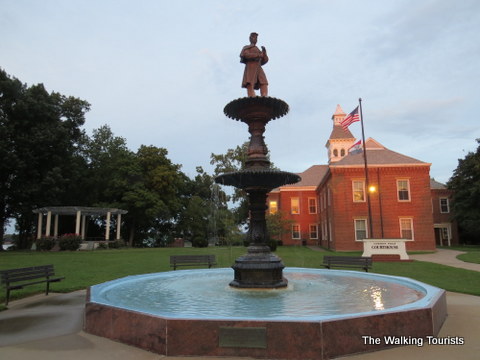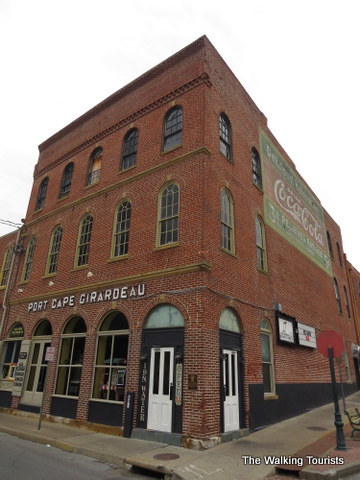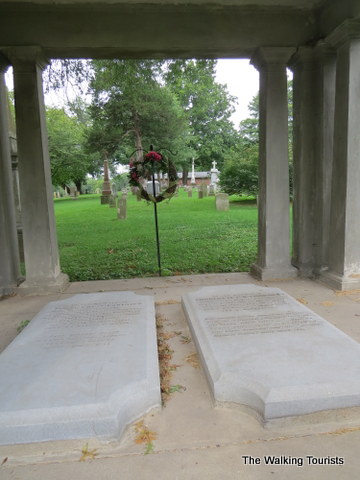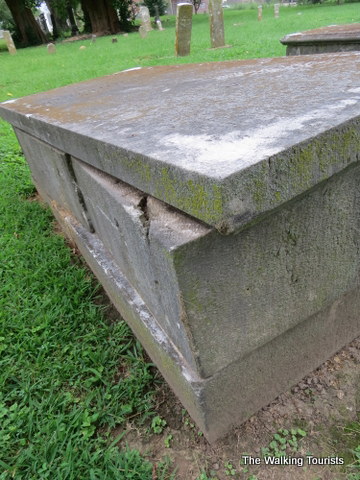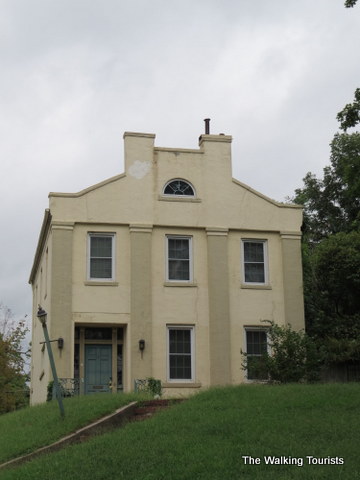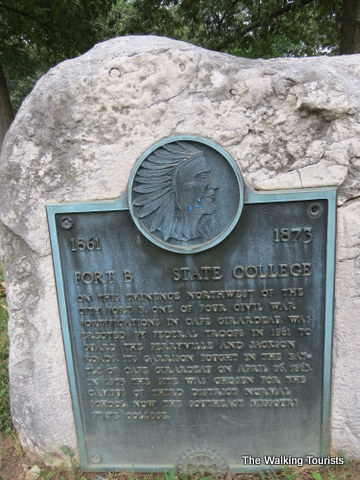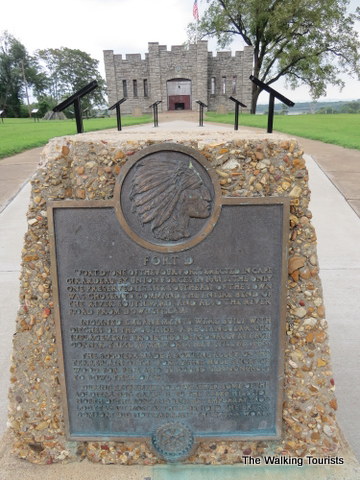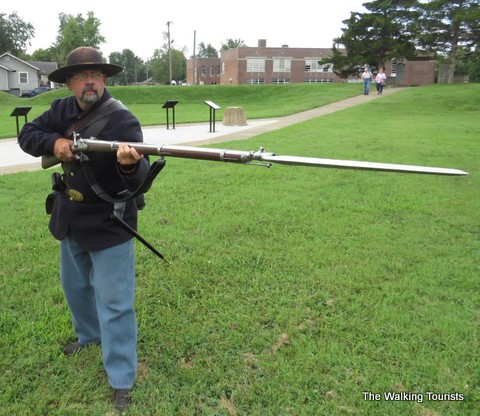Driving through the Civil War in Cape Girardeau
Cape Girardeau was a Union stronghold during the Civil War. The area had its Confederate sympathizers, but the vast majority of the region was pro-Union.
In fact, the Union defended Cape Girardeau from a Confederate attack April 26, 1863. The four-hour artillery exchange became known as the “Battle of Cape Girardeau.” Once the fighting stopped, the Union lost six soldiers and had about a dozen wounded. The Confederates likely suffered twice as many casualties and wounded.
An interesting note (to me only, perhaps) is that the Union regiment defending Cape Girardeau at the time with was the First Nebraska Infantry. The Nebraska unit was stationed at Cape for a while in the mid-1860s. It was known as a hard-fighting and hard-drinking group of men, a Civil War re-enactor told me.
Following the battle, the 1st Nebraska was transferred south. Later, on a return trip through Cape Girardeau, the steamboat transporting the unit docked. Merchants were quick to roll barrels of liquor and other “goodies” to the docks. As the boat readied for its midnight departure, Nebraska soldiers had to be carried on to the boat or pulled from the water after falling overboard. They appeared to have enjoyed their short stay with lots of booze.
The Cape was protected by four forts built in 1861 – A, B, C and, yep, D. The Battle of Cape Girardeau involved mainly Fort B. The forts were ordered built by General John C. Fremont. The construction was overseen by Lt. John W. Powell, who later was credited with ‘discovering” the Grand Canyon.
The Cape’s Convention and Visitors Bureau offers a driving tour of key Civil War points around the city. It focuses on nine specific stops, while mentioning other key information. The drive is quite easy to complete. It can take 1-2 hours, depending on how much time you spend at spots.
The tour starts along the riverfront. Port Cape Girardeau (now a restaurant) may have been used by General US Grant early during his command, before he moved it across the Mississippi River to Cairo, Illinois.
Next stop is the Old Courthouse Park. Here you will find a small monument recognizing the Confederate States of America, a Union memorial water fountain, and the Old Courthouse. The courthouse, which was built in 1854, served as an office for the Union Provost Marshal. The basement dungeon was used to hold Confederate soldiers and sympathizers, as well as some Union soldiers facing charges.
Fort A was built in this area. It had a view of anyone approaching from the north. Residences and streets cover the original fort location today.
The Old Courthouse space is used for concerts and other public events, as it remains a popular gathering area.
The third stop was one of our favorite spots – Old Lorimier Cemetery, just a few blocks from the riverfront area. Here, you’ll find grave markers from the 1800s, including Civil War soldiers. The founder of the city – Pierre Lorimier – is buried next to his wife, Charlotte approximately in the center of cemetery. The cemetery is the final resting place for several key figures in the history of Cape Girardeau.
Soldiers are also buried here in unmarked graves.
One crypt caught our attention right away. The top was moved a bit. We wondered if someone was trying to get in OR was someone trying to get out.
Along the way to our next point of interest, we passed the Minton House, which was used as a hospital to treat small pox during the war.
Fort B was our fourth visit on the tour. A monument recognizing the fort is located on the campus of Southeast Missouri State University.
Fort B, which was directly involved in the Battle of Cape Girardeau, was open-sided, with earthworks (berms) on the west and north sides. Fort B had 24-lbs. guns – with a range up to a mile – to use during the fight.
The fifth stop was the new Lorimier Cemetery. The hills on either side of the cemetery represented the division of the Union and Confederate soldiers. This territory was manned by the 1st Nebraska infantry.
Next stop – the actual site of the Battle of Cape Girardeau. A monument recognizes the site of the April 1863 conflict.
The Confederates attacked using two columns. Once it was determined they couldn’t take the Cape because of the fortified hills, they ordered a line attack to allow time for a retreat.
Fort C marks the seventh stop on the driving tour. The marker is located behind a fence on private property. You can see it clearly through the fence grates.
The fort was supported by the 2nd Missouri State Militia Calvary and the 1st Wisconsin Calvary.
My favorite stop on the tour was No. 8 on the map – Fort D Historic Site. The current building was constructed during the depression, as part of the Works Projects Administration projects to help create jobs.
The original fort was located a short distance away at the same spot. Fort D offers a great history lesson with a series of information in framed stops on the park grounds.
Fort D was never fired upon during the war. In fact, the fort used “Quaker” cannons. These were long log pieces painted black with small holes drilled in the front. They gave the illusion of being real cannons from the river. Fort D was likely used as a training fort, I was told.
The site is home to a few Civil War re-enactments annually. We were fortunate to catch a few soldiers during our visit. These guys strive for accuracy. I took a picture of one man, and he removed his eye glasses, because they were “not period-authentic.”
The re-enactors set up camp for the day. They gave public demonstrations of cannon firing, bayonette attachment to rifles and rifle shooting. Nearby, a group of musicians played period pieces of instruments.
The final stop is St. Vincents Seminary, which is now part of the Southeast Missouri’s performing arts program on the river campus. The location is next to the riverfront park, which allows visitors a great view of the bridge area.
The Cape Girardeau area is also part of a larger Civil War tour area, consisting of southeast Missouri. In addition to the Cape, you can drive westward through Jackson to see some sites. The tour eventually heads northward toward St. Louis.
If you are a Civil War buff or just interested in the area’s history, we urge you to take the tour. It was a fun and interesting way to learn about Cape Girardeau’s involvement.
For more information on the driving tour or other points of attraction, please visit check out the visitors bureau website at www.visitcape.com.
For more information on the Fort D Historic Site, please check out www.fortdhistoricsite.com.





